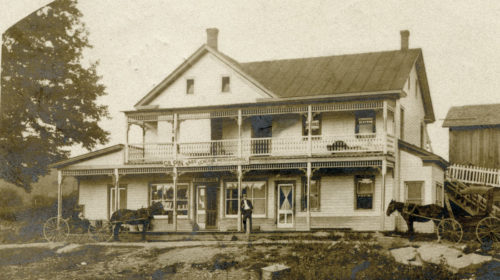
Local History

The Mills of Lower Mill Creek 1830–1930
During the mid-nineteenth century, Lower Mill Creek was the focal point for intensive water-powered industrial development. The area was composed of the Rohrbacker gristmill, farm and butcher shop, and the Haag gristmill. Both mills did small-scale barter or custom milling for local farmers. They remained in their respective families for three generations and continued to operate into the 1920s. The wooden mill buildings were washed away in the Flood of 1955. The houses, barns and outbuildings that remain today represent our agricultural economy of the nineteenth century.
From Tannerytown to Ledgedale Recreation Center
The story of Ledgedale begins with a tannery established by Burton Morss on the banks of Wallenpaupack Creek in the mid-1800s. However, leather tanning was a fleeting industry. It disappeared with the hemlocks a few decades later, to be quickly replaced with a huge man-made lake and the rise of the tourism industry.
The Ladies Aid Society—Pillar of the Church
Beginning in the mid-1800s, Ladies Aid Societies were formed for the purpose of assisting their local churches socially and financially. Our Greene-Dreher churches benefited from the financial support of Ladies Aids, and the community enjoyed their social events and charitable work that extended beyond the church.
Pennsylvania’s Justice Bell — Symbol of Women’s Suffrage
September 25, 2020, marked the 100th Anniversary of women’s right to vote. It was on that day 100 years ago that Pennsylvania’s Justice Bell rang out for the first time to celebrate the ratification of the 19th Amendment and the success of the women’s suffrage movement. The women of Pennsylvania played a key role in that victory.
Faire Greene — The History of Greene Township
Immigrant families from Germany and other European countries began settling along the South and East Branches of Wallenpaupack Creek in the early 1800s, establishing farms, shops, schools, churches and post offices, thereby creating the first small villages in what would be Greene and Dreher Townships.
The Newfoundland Settlement and the Moravian Church Mission
In the 1830s a hardy group of German immigrants banded together to form a settlement along the banks of the Wallenpaupack Creek in what was then Sterling Township, Wayne County. They built a church in the wilderness and called it Hoffenthal, or Hopedale, a name that reflected their hopes and dreams for a new life in the New World.
Local History Past-Port
A free guide to historical sites in the Northern Pocono Mountain region. The region has a rich and varied history and many of the historic sites are preserved and open to the public. Collect Past-Port stamps from ten of the sites when you visit them and receive a free prize!